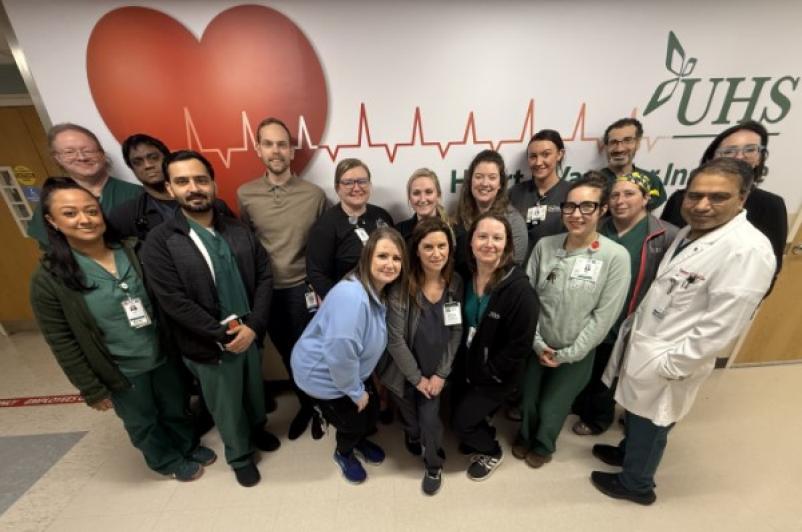
While many people are familiar with deep-vein thrombosis – blood clots in the legs due to extended immobility or injury – a resulting condition may be less well-known: Pulmonary Embolism, or PE. A PE occurs when a blood clot travels from the legs to the lungs, obstructing pulmonary blood flow, stressing the right side of the heart, and decreasing the body’s ability to oxygenate blood and deliver it to the rest of the body. It’s an emergency of similar severity to a heart attack or stroke and is the third leading cardiovascular cause of death in the U.S.
Symptoms of PE include shortness of breath and chest pain, which can be easily mistaken for other, more benign concerns or be confused for heart attack symptoms. “It can be hard to differentiate PE from a heart attack, and as the patient, you don’t need to. Just get to the hospital,” said Alon Yarkoni, MD, Director of UHS’ Structural Heart Program and Associate Director of the Cardiac Catheterization Lab. Typical diagnostics used in this scenario include an echocardiogram and a CT scan.
PE is a life-threatening emergency, though it typically allows for more time to initiate treatment compared to a heart attack or stroke. Following diagnosis, patients are treated with blood thinners. In some cases, a clot-busting infusion of thrombolytics may be administered. For select patients, a mechanical thrombectomy using the Inari Medical FlowTriever system is also an option. This non-surgical, minimally invasive procedure removes the pulmonary artery clots.
Mechanical thrombectomy, available for about a decade, has grown in popularity due to its proven effectiveness. Said Dr. Yarkoni, “In the last two to five years, trials comparing mechanical thrombectomy to standard therapy have shown a proven benefit for both treating the acute episode and avoiding long-term complications like residual pulmonary blood clots, reduced heart and lung function, and decreased exercise tolerance.”
Dr. Yarkoni, who received specialized training in mechanical thrombectomy during his structural heart fellowship at Henry Ford Hospital in Detroit, began performing the procedure at UHS in March 2022 and has completed approximately three dozen cases since then. “We’re seeing good outcomes for carefully selected patients,” he said. Mechanical thrombectomy is an acutely necessary medical procedure covered by Medicare and major insurance plans.
The Pulmonary Embolism Response Team, or PERT, assesses patients carefully as candidates for mechanical thrombectomy. This group includes pulmonologists, cardiologists, anesthesiologists, cardiothoracic surgeons, and radiologists, all collaborating to review diagnostic information and recommend the best, safest treatment for each patient.
According to UHS pulmonologist Muhammad Imtiaz, MD, the PERT model is critical: “Most PE patients become long-term pulmonary care patients, so pulmonary and critical care professionals are a crucial part of the PERT. This comprehensive team approach also helps diagnose the subset of patients who may not be candidates for thrombolytics, such as those with a high clot burden, heart strain, or high risk for intracranial bleeding.”
Chenango Bridge resident Ken Semanovich, 71, can personally attest to the value of PERT at UHS. After accidentally gouging his lower leg on a picnic table crossbar, he had weeks of leg pain, which progressed into worsening fatigue. “Finally, mowing the lawn took me 30 minutes longer than usual, and when I came inside, my wife commented that I didn’t look right. I told her I didn’t feel right, either,” he said. Mr. Semanovich saw a primary care provider doctor the same day. She promptly ordered a stat ultrasound at UHS Wilson Medical Center, which revealed blood clots in his leg. Released with oral blood thinners, Semanovich was halfway home when his cell rang – the primary care office asked him to return to Wilson Medical Center for a pulmonary CT, which showed clots across both lungs.
The next morning, Dr. Yarkoni presented three options: continue oral medication, receive intravenous medication to break up the clots or try this new procedure, which is what I chose,” he said. The mechanical thrombectomy was completed the same day, and Mr. Semanovich felt better immediately: “My fatigue went away. I feel tremendously better, and I have only the best to say about the entire staff, from the ER and ICU to the pulmonologist and cardiologist.”
Mr. Semanovich was back to mowing the lawn three weeks later, beating his usual time.
Who is at risk?
PE is a concern for individuals:
- who are pregnant/postpartum
- who are obese
- who smoke
- who use contraceptives
- with prior history of stroke
- with high blood pressure
- with cancer
- with extended immobility (such as a long hospitalization or orthopedic surgery)
- undergoing current chemotherapy treatment
For more information about mechanical thrombectomy for PE, visit nyuhs.org.


